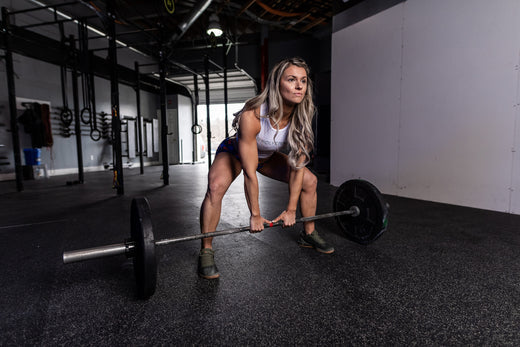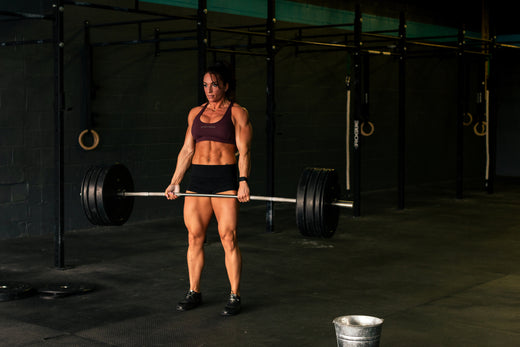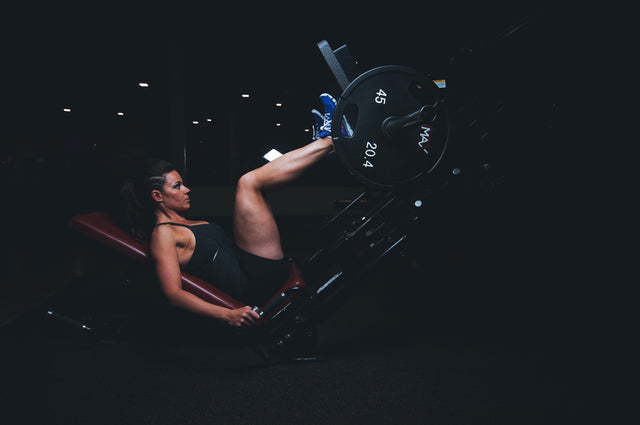Perhaps one of the most effective exercises, the deadlift is a tried-and-true compound functional movement that is utilized to build full body strength for more explosiveness, speed, and power. The deadlift, much like many other resistance training exercises, comes with many variations which include the Romanian deadlift, straight leg deadlift, and the sumo deadlift. We’re going to discuss the differences and similarities between these deadlift variations so you can decide which one to include in your strength training program.
Benefits Of Deadlifts
1. Deadlifts Improve Posture
The majority of us have postural imbalances, and many are quad dominant, meaning that most of the muscle mass in our legs is attributed to the quadriceps. Thus we develop a structure that lacks balance, since the hamstrings are an often neglected and forgotten muscle group, leading to an innumerable amount of issues such as hunched shoulders, a weakened core, and underdeveloped glutes, which makes us prone to lower back issues.
Posterior training will with deadlifts help reduce these risks and give you a stronger posture for proper spinal support and a stronger back. Not to mention, help you carry yourself with more confidence [R]. Improper posture can lead to muscular imbalances, disrupting your body's homeostasis, creating overcompensation, muscle tightness, and making your more prone for injury. Deadlifts can help you build bigger hamstrings and glutes, and develop a stronger back, lats, and core.
2. Deadlifts Burn More Body Fat
The more muscle mass you have, the more calories you burn at rest. Strength training and exercise movements such as the deadlift will help build more muscle mass, therefore burning more calories at rest, boosting your metabolic rate. Resting muscle tissue burns 6kcal/lb per day at rest, thus the more muscle you have, the more calories you burn.
Post workout your metabolism stays elevated through a process called excess post-exercise oxygen consumption (EPOC). EPOC also know as the after-burn effect, refers to the oxygen and energy (in calories) it takes for your body to repair your muscle tissue during recovery. EPOC can be a major contributor to your total daily caloric expenditure by increasing your body’s thermic effect [R]. Prolonged workouts with more intense resistance training at heavier weights have been associated with a more substantial EPOC [R].
3. Deadlifts Improve Total Body Strength
One of the best benefits of deadlifts, is the total body strength they can produce. Deadlifts are a compound movement, meaning they use multiple muscle groups, joints and stabilizing muscles, in unison, giving you more bang for your buck when it comes to building more strength.
According to a study published in the Journal Of Strength & Conditioning Farley, K. (1995). Analysis Of The Conventional Deadlift. Strength & Conditioning Journal, deadlifts activate many of the large muscle groups in the lower as well as the upper body, including the gluteus maximus, hamstrings, quadriceps, abdominals, and latissimus dorsi (lats).
If the goal is strength and body aesthetics, deadlifts are going to hit all the sweet spots, and help you build bigger quads, active your glutes to build a bigger butt, stronger abs, better hip mobility, and a more defined back.
RELATED ARTICLE How To Get Stronger In 3 Simple Steps
4. Deadlifts Build More Muscle Mass
Deadlifts are generally your heaviest lift and a compound movement that uses many different muscle groups. Therefore, by incorporating deadlifts into your training program, you'll gain more lean muscle mass when performed correctly.
Deadlifts build core stability, gripping strength and many different muscle groups in your posterior chain such as your back, legs, shoulders, and arms. Not only that but deadlifts build your glute muscles. With stronger glutes, hamstrings, and better core strength, you'll have more explosive power and endurance, improving overall athletic performance.
RELATED ARTICLE How Do Muscles Grow
Deadlift Vs. Romanian Deadlift (RDL), Straight-Leg Deadlift, & Sumo Deadlift
1. Conventional/Traditional Deadlifts
The Deadlift. The “dead” from deadlift, comes from lifting “deadweight” off the floor. As intimidating as it may sound and look, the conventional deadlift is one of the best compound, functional, and effective exercise movements that can bring more benefits in one fluid motion, than nearly every other lift in the gym. Part of what’s called the “big-3” (deadlift, squat, bench-press) the deadlift activates multiple muscle groups at the same time.
Deadlifts have many known full body benefits and are extremely crucial in the development of total-body strength, proper hip function, core strength, and spine stabilization (which can reduce the risk of lower back injuries). Since deadlifts recruit multiple muscle groups, joints, and stabilizing muscles, they also burn more calories and more body fat as compared to other exercise movements. With the proper form, the deadlift can add a ton of performance and health benefits, to your training program.
2. Romanian Deadlift
The Romanian deadlift or commonly known as the RDL, is a functional compound strength movement and variation to the traditional deadlift. Most often used as an accessory lift, with a submaximal load, the Romanian deadlift has many applications in strength training, as well as high-intensity functional training programs.
The Romanian deadlift is slightly different than the traditional deadlift. Although both movements will increase strength and produce greater muscle hypertrophy in the posterior chain muscles, Romanian deadlifts put more emphasis on the hamstrings, as opposed to the glutes [R]. Electromyography (EMG) studies show that conventional deadlifts target and recruit the gluteus and rectus femoris muscles more so than the RDL, due to the biomechanical differences in exercise technique as the conventional deadlift starts and finishes more in a sitting position than the RDL with significantly more knee and hip flexion [R].
The primary muscles involved in the RDL are the posterior chain muscles, including the erector spinae, trapezius, gluteus maximus, hamstrings, and adductors.
Deadlift Vs Romanian Deadlift (RDL)
When you compare the deadlift vs Romanian deadlift, there are a few significant differences when it comes to muscle activation and biomechanics. However, the conventional and Romanian deadlift are also very similar.
In a study published in the journal of Exercise Science and Fitness had 21 male study participants perform the conventional and Romanian deadlift to investigate biomechanical differences amongst the two lifts. Electromyography tests found that the conventional deadlift results in significantly more torque, and found more muscle activation in the rectus femoris and and glutes, and greater knee extension and torque [R]. Thus, the conventional deadlift puts a greater emphasis on your butt, as opposed to the Romanian deadlift, further activating the trunk and helping you build a bigger booty.
3. Straight Leg Deadlift
The straight leg deadlift (SLD), often confused with the Romanian deadlift, is yet another free-weight deadlift variation used with a traditional barbell. RDL is performed with the knees bent at a 15-degree angle, throughout the movement. The straight leg deadlift involves keeping the legs almost completely straight with no flexion in the knees as the barbell is brought down. However, unlike the RDL, as the barbell descends towards the ground, it does not remain in close contact to the legs.
Deadlift Vs Straight Leg Deadlift
A study published in the Journal Of Exercise Physiology compared the myoelectric activities of the conventional deadlift vs the straight leg deadlift of the lower extremity muscles involved in the contraction. The studies revealed that the conventional deadlift showed a significantly higher vastus lateralis activity while the SLD exhibited a significantly greater medial gastrocnemius activity [R].
Besides muscle activation, biomechanical differences, and the initial set-up of the exercises are quite different. Deadlifts use knee, and hip flexion, while simultaneously stimulating several secondary muscles in the lower extremities, such as the quadriceps, hamstrings, and glutes, while straight leg deadlifts, emphasize the hamstrings and gluteus maximus, with a submaximal load.
During the movement, bar positioning and feet positioning are also different. Conventional deadlifts utilize a wider stance, while straight leg deadlifts typically involve a narrower stance, with the bar following a hollow path, as opposed to being in close proximity to your legs. Conventional deadlifts are also performed from a position where your spine is extended, your chest lifted, and your weight is sitting back in your heels, with your hips rolled back.
4. Sumo Deadlift
The sumo deadlift is common amongst powerlifters. Sumos are performed with a wider stance than the conventional deadlift, which translates into a shorter traveled distance from the dead weight from the floor to a fully extended standing position [R] Like other deadlift variations, biomechanic variations exist between the conventional deadlift vs sumo deadlift, as well as lifting technique differences, and muscle activation.
Deadlift Vs Sumo Deadlift
A three-dimensional analysis published in the journal of Medical Science and Sports Exercise at Duke University compared the biomechanics of the traditional deadlift vs sumo deadlift. Two video sessions of 12 sumo and 12 conventional style lifters at a national powerlifting championship compared the two lifts and were quantified at barbell liftoff (LO), at the instant the barbell passed the knees (KP), and at lift completion.
At lift-off and KP, thigh position was 11-16 degrees more horizontal for the sumo group, whereas the knees and hips extended approximately 12 degrees more for the conventional group. The sumo group had 5-10 degrees greater vertical trunk and thigh positions, employed a wider stance, turned their feet out more and gripped the bar with their hands closer together. Vertical bar distance, mechanical work, and predicted energy expenditure were approximately 25-40% greater in the conventional deadlift group [R].
Strength, mobility, and hypertrophy is achieved through greater range of motion, while simultaneously intervening more secondary muscle groups. Functional strength is also based upon optimizing human movement, through mimicking and replicating those movements through strength conditioned exercise. My advice, if you’re not planning on competing in Olympic weightlifting, sumo deadlift has little to no benefit for the average gym goer. The conventional deadlift will attribute greater benefits to full and total body strength, functional movement, and mobility than the sumo deadlift.
Deadlift Vs Romanian, Straight Leg, & Sumo Deadlift: Takeaway
Several studies have shown that each deadlift variation has several biomechanical differences. Dependent upon your goals, including the deadlift and variations of the deadlift in your training program, will depend on your training and aesthetic goals. Variety in exercise selection is an important factor in developing and building more muscle mass, while overcoming strength plateaus. Determining your goals, will help you better understand which deadlift to include in your training protocol.
Need Help With Optimizing Your Diet And Nutrition Plan To Finally Get The Results You've Been Waiting For?
SWOLVERINE IS AN ENDURANCE ATHLETE AND ACTIVE LIFESTYLE BRAND. MADE FOR THE ELITE ATHLETE, AND THE STRONG-WILLED OUR PRODUCTS WERE DESIGNED TO FUEL YOUR ATHLETIC PERFORMANCE. WE PERFORM WHEN YOU PERFORM.
We believe that everyone can optimize not only their athletic performance but their human potential. The way we believe we can optimize performance is through transparency, clinically effective doses, and clinically proven ingredients with evidence-based outcomes. We provide the nutrients you need to power your active lifestyle.
References
Bezerra E.S., Simao R., Fleck S.J. Electromyographic activity of lower body muscles during the deadlift and still-legged deadlift. J Exerc Physiol. 2013;16:30–39. [Google Scholar] [Ref list]
Escamilla RF, Francisco AC, Fleisig GS, Barrentine SW, Welch CM, Kayes AV, Speer KP, Andrews JR. A three-dimensional biomechanical analysis of sumo and conventional style deadlifts. Med Sci Sports Exerc. 2000 Jul;32(7):1265-75. doi: 10.1097/00005768-200007000-00013. PMID: 10912892.
McAllister MJ, Hammond KG, Schilling BK, Ferreria LC, Reed JP, Weiss LW. Muscle activation during various hamstring exercises. J Strength Cond Res. 2014 Jun;28(6):1573-80. doi: 10.1519/JSC.0000000000000302. PMID: 24149748.
Piper T.J., Waller M.A. Variations of the deadlift. Strength Condit J. 2001;23:66–73. [Google Scholar] [Ref list]
McGuigan M.R., Wilson B.D. Biomechanical analysis of the deadlift. J Strength Condit Res. 1996;10:250–255. [Google Scholar] [Ref list]
Lee, Sangwoo et al. “An electromyographic and kinetic comparison of conventional and Romanian deadlifts.” Journal of exercise science and fitness vol. 16,3 (2018): 87-93. doi:10.1016/j.jesf.2018.08.001








